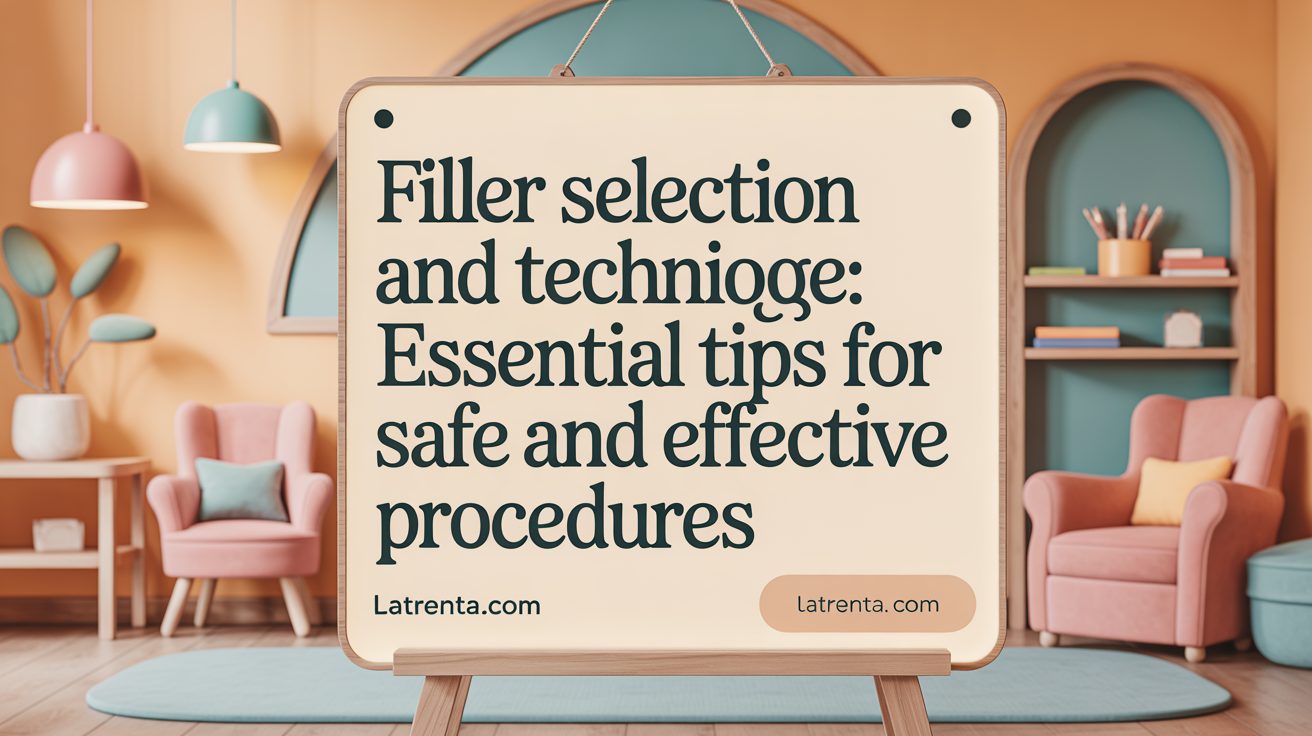Understanding the Challenge of Filler Migration
Dermal fillers have revolutionized facial aesthetics, offering non-surgical rejuvenation and enhancement. However, filler migration—where injected material shifts from its intended site—poses a challenge that can compromise results and patient satisfaction. This article explores the underlying causes, prevention strategies, and management options related to filler migration, emphasizing the importance of proper technique and professional expertise in achieving safe, natural outcomes.
Core Concepts and Causes of Dermal Filler Migration

What are the core concepts and causes of dermal filler migration?
Filler migration occurs when the injected material moves away from its initial placement, leading to visible irregularities such as lumps, bumps, or uneven contours. This phenomenon can compromise aesthetic results and cause patient concerns.
The primary causes of migration are often related to injection techniques and procedural choices. Poor technique, including superficial placement, injecting too quickly, or using excessive volume, increases the risk. Improper product selection—such as choosing a filler with unsuitable rheological properties for a specific area—also plays a role.
Facial anatomy and natural movements significantly influence migration tendencies. Areas with high mobility, like the lips and under-eye regions, are more prone to product shifting. Movement exerts pressure on the filler, especially if injected improperly.
External factors, such as pressure, trauma, or massage soon after treatment, can displace the product. Additionally, the type and volume of filler used are crucial; thicker, more viscous fillers tend to stay in place better, while overfilling can cause the product to move or spread.
Understanding the underlying anatomy and applying precise injection techniques—using proper depth, angle, and gentle pressure—are essential for minimizing migration risk. Selecting qualified practitioners and adhering to clear post-treatment care instructions further support optimal outcomes.
Common areas affected include lips and under-eye regions, where natural movements and thin skin make migration more likely. Correct product choice, conservative volume, and cautious handling help ensure the filler remains in the intended position, maintaining natural and balanced results.
Proper Injection Techniques to Minimize Filler Migration

What are proper injection techniques to prevent filler migration?
Preventing filler migration relies heavily on combining expert knowledge with meticulous technique. A fundamental step is thorough understanding of facial anatomy. Knowing the layers of tissue, blood vessels, nerves, and the natural movement of facial muscles guides precise placement.
Injectors should focus on selecting the correct tissue plane—deep enough to secure the filler but not so deep as to risk vascular or lymphatic spread. In particularly mobile areas like lips and under-eye regions, avoiding superficial or overly superficial placement reduces the risk of migration.
Using low-volume injections with gentle, controlled force helps maintain control during the procedure. Employing the proper needle or cannula size and maintaining optimal angles during injections enhances product stability.
Refraining from overfilling the area and limiting the number of repeated treatments in the same location also minimizes the chance of filler shifting over time. Slow, deliberate injection with attention to resistance and patient response decreases pressure and inadvertent displacement.
Early signs of migration such as lumps or uneven contours should be promptly recognized, allowing for timely management, including potential use of hyaluronidase for dissolving the filler.
Overall, a combination of detailed anatomical knowledge, careful technique, and conservative treatment planning plays a crucial role in ensuring aesthetic results without unintended spreading of the filler.
Best Practices and Post-Treatment Care for Safe Filler Procedures

What best practices and guidelines ensure safe filler procedures and minimize migration risks?
Ensuring safety during dermal filler treatments involves multiple crucial steps. Most importantly, selecting licensed and experienced practitioners is vital. Skilled injectors have an in-depth understanding of facial anatomy and advanced injection techniques, which significantly reduces the chances of filler migration.
Moreover, choosing FDA-approved fillers from reputable sources helps optimize results and safety. Proper patient assessment, including evaluating facial structure and discussing medical history, sets clear expectations and conditions suitability.
During the procedure, small, controlled doses of filler should be used, with caution to avoid overfilling or injecting into the wrong tissue plane. Techniques such as slow injection, using appropriate needle sizes or cannulas, and adhering to aseptic protocols further minimize risks.
Post-treatment, strict adherence to care instructions—like avoiding touching or massaging the area—plays a big role in preventing migration. Patients are advised to stay away from strenuous activity, heat exposure, and facial massages for at least 24-48 hours. Applying ice can help reduce swelling.
Lifestyle factors also matter; managing smoking and ensuring proper hydration support the stability and longevity of the filler. Regular follow-ups allow providers to monitor results and address any early signs of migration promptly.
How does post-treatment care reduce swelling and dermal filler migration?
Post-treatment recommendations primarily focus on avoiding pressure, friction, or trauma to the treated area. Such actions could displace the filler from its intended location, resulting in lumps, asymmetry, or unnatural contours.
Patients should refrain from pressing or massaging the treated zones unless instructed, as this can promote filler migration. Keeping facial movements gentle during the initial healing phase helps stabilize the product.
Elevating the head, especially sleeping on the back, and avoiding heat, intense workouts, or skincare procedures that cause facial stress minimizes swelling and reduces movement. These measures support proper settling of the filler, ensuring optimal aesthetic outcomes.
In summary, careful post-care significantly diminishes swelling and migratory risks by maintaining a stable environment for the filler to integrate naturally into tissues.
Technical Considerations and Filler Selection to Prevent Migration

What technical considerations help avoid undesirable filler movement?
Preventing filler migration relies heavily on proper technique and understanding of facial anatomy. Choosing fillers with the appropriate rheological properties, such as viscosity and cohesiveness, tailored to the specific treatment area, is essential. For example, thicker, more cohesive fillers are suitable for areas with more movement or thicker tissues, reducing the tendency to migrate.
Correct placement is crucial; injecting at the right depth—usually within the subdermal or subSMAS layer—avoids superficial placement that can easily shift. Limiting the amount of filler per injection site and reducing extrusion pressure also minimizes tissue trauma and unintended dispersal.
Furthermore, considering the dynamic nature of facial tissues, especially in mobile areas like the lips and under-eye regions, helps prevent displacement. Experienced practitioners often adapt their techniques based on individual patient anatomy, avoiding excessive injections and slow, controlled delivery.
Post-treatment, advising patients to avoid facial movements, pressure, or trauma in the treated area helps maintain filler stability. Proper training in injection techniques and an understanding of facial biomechanics form the backbone of effective migration prevention.
Which types of dermal fillers are less likely to migrate?
Fillers with higher viscosity and a firmer consistency tend to stay in place better than softer, more hydrophilic options. Calcium hydroxylapatite (CaHA) fillers, such as Radiesse®, are examples of this category, providing a denser structure that resists movement.
In contrast, hyaluronic acid (HA) fillers, especially those with low viscosity, are more prone to diffusion due to their hydrophilic nature. Proper technique, volume control, and selection of a product suited for the specific anatomical site are crucial to minimizing migration risks.
While HA fillers are versatile and widely used, the choice of filler should consider the mobility of the area and the tissue characteristics. Permanent fillers, which are less frequently used today, pose higher long-term migration risks, especially if placed improperly or subject to natural tissue movements.
In summary, selecting a suitable, higher-viscosity filler and applying meticulous injection techniques significantly reduce the chance of filler migration, especially in high-movement regions of the face.
Recognizing and Managing Filler Migration Effectively
What are the signs and how to identify dermal filler migration?
Signs of dermal filler migration include palpable lumps, swelling that becomes more noticeable and sometimes painful over time, and asymmetry in facial contours. Commonly affected areas are the lips and under-eye regions, which are particularly susceptible due to their mobility and thin skin. Patients may observe bluish discoloration, known as the Tyndall effect, especially in superficial placement. Clinicians conduct physical examinations involving palpation and visual assessment to detect irregularities. In complex or uncertain cases, imaging techniques like MRI can help determine the exact location of migrated filler and the extent of spread.
What management options are available if dermal filler migration occurs?
Early detection is vital for effective management. One of the primary treatments for hyaluronic acid fillers is the enzyme hyaluronidase, which dissolves the misplaced filler quickly and can restore natural appearance. This treatment is most effective when administered early after migration is suspected.
In addition to enzymatic dissolution, conservative approaches such as gentle massage and warm compresses may be attempted to encourage natural absorption, though their effectiveness varies. In some cases, corrective procedures including additional filler placement or minor surgical interventions might be required, especially if there's persistent deformity or nodules. Patients should consult qualified practitioners promptly to choose the most suitable approach, and follow-up care is important to monitor improvements or address complications.
Role of hyaluronidase
Hyaluronidase plays a crucial role as a reversal agent for hyaluronic acid (HA) based fillers. It breaks down the HA molecules, allowing the problematic filler to be dissolved efficiently. Its use is especially important in cases of migration, overfilling, or undesired effects like lumps and discoloration. Administering hyaluronidase early minimizes patient distress and prevents worsening of the aesthetic issue. The enzyme's safety profile is well established, and it provides a quick resolution in appropriate cases.
Protocols for corrective procedures
Correcting filler migration involves a series of carefully planned steps. Initially, the practitioner assesses the extent of migration and determines whether enzyme treatment is suitable. Precise injection of hyaluronidase is then performed at the affected sites, often in small doses, to break down the misplaced filler with minimal tissue reaction.
Post-application, patients are monitored for reactions or allergic responses. Follow-up treatments might include additional enzyme injections or alternative aesthetic procedures to improve contours. Maintaining clear documentation during correction ensures suitable follow-up and helps in planning further treatments if needed. Training in injection techniques and understanding of facial anatomy are essential for safe and effective management.
Ensuring Safe and Natural Results through Expertise and Care
Filler migration represents a significant but manageable challenge in cosmetic procedures. Understanding its causes—from technique to product choice—and adhering to evidence-based preventive measures significantly reduce risks. The role of skilled injectors knowledgeable in facial anatomy and injection science cannot be overstated; their expertise, combined with meticulous post-treatment care and patient education, ensures both safety and satisfaction. If migration occurs, timely recognition and appropriate management including enzymatic dissolution are instrumental in restoring natural contours and confidence. Ultimately, avoiding filler migration is a synergy of proper technique, individualized treatment planning, and patient cooperation.
References
- How to Prevent Dermal Filler Migration - Limmer Dermatology
- How To Prevent And Manage Filler Migration - Harley Academy
- Filler Migration: Causes, Prevention, and What to Do If It Happens
- Avoiding Filler Migration: The Practitioner's Guide | CAMA
- The Truth About Filler Migration and How to Avoid It - Skinjectables
- Filler Migration Explained: What It Is and How to Avoid It
- Filler Migration: Why It Happens & How We Prevent It
- Avoiding Lip Filler Migration: Tips for a Perfect Pout
- How To Prevent And Manage Filler Migration - Harley Academy
